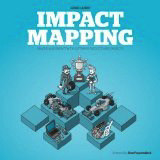Software That Matters: A Review of Gojko Adzic’s Impact Mapping
By Ellen Gottesdiener
 Impact Mapping: Making a Big Impact with Software Products and Projects, by Gojko Adzic, explains how to use an efficient visual modeling technique to ensure that project partners build the right products—or, as the author says, products that have impact. Impact mapping, the subject of this lithe, approachable book, is an adaptation of visual mapping techniques (effect mapping).
Impact Mapping: Making a Big Impact with Software Products and Projects, by Gojko Adzic, explains how to use an efficient visual modeling technique to ensure that project partners build the right products—or, as the author says, products that have impact. Impact mapping, the subject of this lithe, approachable book, is an adaptation of visual mapping techniques (effect mapping).
Using Impact Maps
Impact maps serve to align teams with the business objectives that motivate product development. Impact maps also help teams test their mutual understanding of product goals and expected outcomes, focus teams to deliver the highest-value features, and support collaborative decision making. Thus, impact maps—succinctly and clearly described in Gojko’s book—are a key tool for collaborative planning of product strategy.
This is a book you can reference with ease as you plan and facilitate workshops (collaborative meetings with a clear purpose and outcomes) for planning releases or iterations, product roadmapping, process improvement, and product and team chartering.
And it’s not only for software products. You’ll find impact mapping useful for ensuring the strategic alignment needed for any product, including software, systems, or services.
My own exposure and experience with this type of mapping come from the world of strategic planning and facilitation: concept mapping, influence mapping and diagramming, mind mapping, and, especially, cognitive mapping—visualizing hierarchies of ends and means (or hows and whys) to identify desired outcomes.
Gojko’s book treats these visual tools in the specific context of avoiding the bugaboo of many software projects: building the wrong product. Using this elegant, lightweight tool in the context of a collaborative workshop, you can avoid wasted time and money and focus on what is truly necessary.
Valuable Book Features
Gojko’s book is useful, user-friendly, and desirable—all the characteristics we want in a great resource. It’s visual and fast to use, and it encourages product partners to collaborate, making it useful for building a shared understanding of the big “whys” of our work . It’s usable—easy to read, including engaging cartoons and colorful examples, references, and tips. It’s desirable because it helps you build products that provide impact—aligned with organization goals and objectives and providing evidence of their value.
Design Thinking Patterns
I enjoyed Gojko’s discussion on design thinking, the newer, hip term for a long-standing family of diverge-then-converge practices. I first learned about these practices from the professional facilitation community and described a metapattern of design thinking my first book, Requirements by Collaboration. That pattern, “Expand then Contract,” is an ingredient of successful collaborative sessions.
Impact maps are a good example of this kind of open-and-then-close mental work.
| Value Techniques There are a variety of tools and techniques you can use to elicit, study, and select product options based on value. They include Goal-Question-Metric, Planguage, cause-and-effect diagrams, Analytic Hierarchy Process, decision matrices, Boston Box, Kano Model, The Golden Circle, the purpose alignment model, and more. |
On lean/agile teams, we follow this pattern with product options by exploring the options and then evaluating them for the highest-value ones. Mary Gorman and I extended this metapattern in Discover to Deliver: Agile Product Planning and Analysis with a Confirm action. Thus, the Explore-Evaluate-Confirm pattern (what we call a “structured conversation”) enables partners to make value-based decisions on what to build and when, adding criteria to verify and validate the possible choices.
Impact mapping is useful for setting the stage for this work when the project community gathers to envision the product, identify the partners (customer, business, and technology specialists), and define value criteria. You can combine impact mapping with other valuation techniques, or use it by itself (see box, Value Techniques).
Get the Book, Use Impact Maps!
Try impact mapping and use Gojko’s marvelous book, Impact Mapping: Making a Big Impact with Software Products and Projects, to guide you to do your best, most impactful work.

Leave a Reply